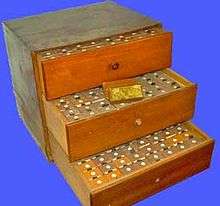Crude drug
A crude drug is any naturally occurring, unrefined substance derived from organic or inorganic sources such as plant, animal, bacteria, organs or whole organisms intended for use in the diagnosis, cure, mitigation, treatment, or prevention of disease in humans or other animals.
Overview

Crude drugs are unrefined medications in their raw or natural forms. Prior to the 1950s, every pharmacy student learned about crude drugs in pharmacognosy class. Pharmacognosy is the study of the proper horticulture, harvesting and uses of the raw medications found in nature.
Raising, harvesting and selling crude drugs was how many large pharmaceutical companies started out. Companies such as Eli Lilly and Company sold crude drugs to pharmacists to save them time and money, but the early pharmacy graduate would know how to raise their own crude drugs if need be.
History

The usage of crude drugs dates to prehistoric times. Traditional medicine often incorporates the gathering and preparation of material from natural sources, particularly herbs. In such practice, the active ingredients and method of action are largely unknown to the practitioner.
In recent history, the development of modern chemistry and application of the scientific method shaped the use of crude drugs. Eventually, the use of crude drugs reach a zenith in the early 1900s and eventually gave way to the use of purified active ingredients from the natural source. Currently the use and exploration of crude drugs has again gained prominence in the medical community. The realization that many completely unknown substances are yet to be discovered from crude drugs has created a new interest in pharmacognosy and has led to many medical breakthroughs.
In 1907, the Pure Food and Drug Act was implemented and standardization of crude drugs took place. Often the USP would specify what percentage of active ingredient was needed to claim a crude drug met USP standards.
An example of standardization would be as follows (from the United States Pharmacopeia):[1]
Opium is the air-dried milky exudate obtained by incising the unripe capsules of Papaver somniferum Linne or its variety album De Candolle (Fam. Papaveraceae). Opium in its normal air-dried condition yields not less than 9.5 percent of anhydrous morphine.
Use in Chinese Medicine
Crude medicine (simplified Chinese: 药材; traditional Chinese: 藥材; pinyin: yàocái), (also known as crude drug in the Chinese materia medica) are bulk drugs from the Chinese materia medica basic processing and treatment.
References
- ↑ 2007 USP